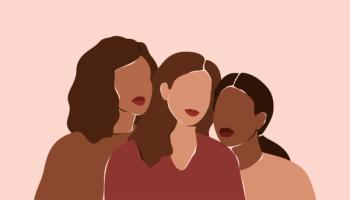
Stitching Time: Women and Fiber Art in Psychiatric History
Sewing, weaving, knitting, crochet, and needlework can all be soothing, expressive, and communal. How did women patients in psychiatric history harness the therapeutic and political potential of fiber art? What can we learn about life in psychiatric institutions from their work?
WOMEN WHO INSPIRE
(In honor of Women’s History Month, we invited our contributors to write about the women who inspire them.—Ed.)
There is a quiet sisterhood in the archives of psychiatric history that is worth reflecting on this Women’s History Month: institutionalized fiber artists. Psychiatric hospital reports from around the turn of the 20th century tell us that many of the women who were admitted at that time were seamstresses or dressmakers, and that many of these women continued to create textiles while in the hospital. Because fiber art is often wearable and functional, it has historically been dismissed as “craft” rather than “art.” However, by contextualizing this work within the institutional history of psychiatry, we get a better sense of how these artists used textiles to maintain their mental health, protest their isolation, and express their individuality in an environment where their aesthetic choices were limited.
For context, most of the sewing, knitting, and mending done by patients in hospitals at this time was unpaid labor for the benefit of the institution. Nineteenth-century hospital reformer, doctor, and architect Thomas Story Kirkbride, MD, lumped together amusements and labor in his 1854 treatise, On the Construction, Organization, and General Arrangement of Hospitals for the Insane. From the perspective of doctors and administrators, both labor and entertainment were good for the “management” of patients and the economy of the hospital. Kirkbride wrote that “the provision of adequate and comfortable workshops [such as sewing rooms], in a convenient position, and under the care of competent superintendents, may be made a source of profit to an institution, and furnish another means of labor of an interesting kind to a large number of the insane.”1 (We might note that Kirkbride’s writing here places the hospitals’ profit in front of the interests of patients.)
Textile labor was performed in a supervised, highly regulated environment. Women worked at sewing machines arranged in even rows in the sewing room or behind a designated piece of equipment in an industrial textile room, as seen in photographs from Bryce Hospital in Alabama, 1916 (Figures
Hospitals that used steam-powered sewing machines reported that their sewing rooms were noisy and hot and required fans and ventilation.4 Each piece that the women patients produced was itemized and recorded, as in this chart from the Oregon State Insane Asylum’s 1897-1899 Annual Report (
If it were not for the exploitative labor conditions and unhealthy physical environment, Kirkbride would not have been wrong to include fiber art as a therapeutic practice in these hospitals. Studies today have shown that knitting has significant therapeutic potential, with knitters reporting that the practice may heighten cognitive functioning, lower stress levels,6 and even aid in recovery from eating disorders.7 Scholars and practitioners have noted that textile art like quilting involves repetition, modulation, and sensory pleasure, all of which are boons to creators’ mental health.8 These benefits are even greater when sewing, knitting, crocheting, or needlework is part of one’s daily routine.9 This may explain, then, why women in psychiatric hospitals seem to have continued these practices outside of the sewing rooms.
Beyond enforced labor and personal benefits, women patients also created fiber art to maintain community and protest their isolation. While many artistic mediums evoke an image of a lone genius painting or sculpting in isolation, knitting, sewing, and needlework have historically been done in community with other women. Patient and advocate Elizabeth Parsons Ware Packard chronicled in her 1868 memoir, Modern Persecution, or, Insane Asylums Unveiled, an episode wherein she realized that her letters home were censored by doctors and administrators. In response, she penciled a letter to her daughter on the back of some clothing that she had embroidered. Although the doctor discovered her plot and had the clothing laundered before mailing it, Packard’s plan shows that she viewed her fiber art as an important connection between herself and the other women in her life, and that she expected her male doctor to overlook the importance of it.10
Packard’s attempt to use a communal and historically female mode of expression to reach outside of the hospital walls and speak to her daughter places her in a long line of women in history and literature who have used fiber art as a means for communication and connection with other women. We might think of the language of textiles spoken by the women in Susan Glaspell’s 1917 short story, “A Jury of Her Peers,” who recognized the protagonist’s apparent distress from her increasingly haphazard quilt. We might think of the intergenerational community of the Gee’s Bend quilters of Alabama, a group of Black women artists who have carried on the quilting methods of their enslaved ancestors and who founded the Freedom Quilting Bee.11 We might also add to these groups of women other textile artists who have experienced violence at the hands of patriarchal systems. For example, the creators of the AIDS Memorial Quilt—many of whom were LGBTQ—paid tribute to those lost to the disease with a staggering 50,000 panels. While fiber art may have individual psychological benefits, it is also a radically communal and expressive art form.
In an asylum environment where patients were denied most avenues for aesthetic choice, women artists also used textiles to transform their environment and express individuality. The photos in Figures 4 and 5 are from the Prinzhorn Collection, a collection of psychiatric patients’ art from Germany in the early 20th century. The original Prinzhorn Collection contained about 5000 drawings from about 500 patient-artists; while the male painters in the collection have garnered critical interest over the past century, only 80 of these artists have been identified as women, and their contributions have been largely overlooked.12 Many of these women were seamstresses by trade, and their contributions were often made not with paint, but with textiles.
One such artwork is Agnes Richter’s jacket (
Another textile artist in the Prinzhorn Collection claimed agency over her highly controlled environment through installation pieces.
Women have been using fiber art for millennia to build community, heal, express themselves, and protest authority. We see this manifest today in burgeoning studies on the mental health benefits of textile art, the signature homemade “pussy hats” at the 2017 Women’s March, and the freely available patterns and resources for mask-making shared by sewing groups on social media in the early days of the pandemic. These innovative and communal artistic practices have a long history, and the women in the archives of psychiatric history are a crucial part of that lineage.
Dr Glew studies English at Penn State University. She teaches writing and disability studies and writes about psychiatric history, narrative medicine, and disability.
Is there a woman who inspires you? Write to us at
References
1. Kirkbride TS.
2.
3.
4.
5.
6. Riley J, Corkhill B, Morris C.
7. Clave-Brule M, Mazloum A, Park RJ, et al.
8. Dickie V.
9. Conner TS, DeYoung CG, Silvia PJ.
10. Packard EPW.
11.
12. Busine L, Brand-Claussen B, Douglas C, et al.
13.
14. Hornstein G.
15.
Newsletter
Receive trusted psychiatric news, expert analysis, and clinical insights — subscribe today to support your practice and your patients.

















